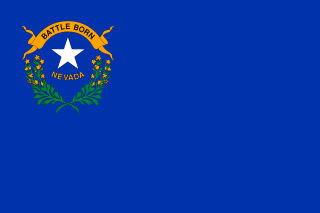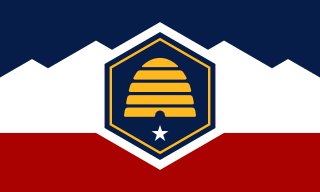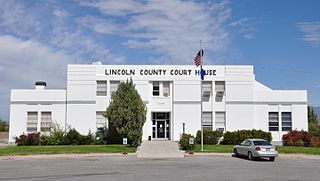
The Pilot Range is a mountain range straddling the border of Box Elder County, Utah and Elko County, Nevada, United States. Lying 50 miles west of the Great Salt Lake, the range forms part of the north-west border of the Great Salt Lake Desert. The range reaches a maximum elevation of 10,716 feet at the summit of Pilot Peak. Most of the range is public Bureau of Land Management land and thus has no access restrictions. Its principal uses are mining, livestock grazing, and seasonal elk and deer hunting.

The Star Range is an 8-mile (12 km) long, small mountain range located in central Beaver County, Utah. The range is "star" shaped as small ridges end at peaks, like fingers of a hand. Another adjacent range sequence southwest, the Shauntie Hills has other fingers of the star-shape.

The Humboldt Range is a largely north-south running range of mountains in northwest Nevada, USA, that extend from the town of Imlay in the north to the junction with the West Humboldt Range in the south. It is bordered continuously by Interstate 80 and the Humboldt River, largely expanded in the form of the Rye Patch Reservoir in this area, on the west side and by a long and fairly broad Buena Vista Valley to the east, in a typical basin-and-range pattern. The Humboldts are ostensibly visible to travelers along Interstate 80, especially with respect to the highest point of the range, Star Peak, which with a quite nicely defined tip reaches an elevation of 9,836 feet, located in the center of the north range section. The midpoint of the range is in the area of Fourth of July Flat. The Humboldt Range is also noteworthy for having a famous historical town at its base on the eastern side called Unionville, which, for a brief period, was home to Samuel Clemens. Another historical site, now a ghost town, nearby is called Star City. Unlike some ranges in the vicinity, the substantial height of the Humboldts allows for a number of continuously flowing watersheds, and hiking the terrain is a somewhat noted activity.

The Seaman Range is a 30-mile (48 km) long mountain range in Lincoln and Nye counties, Nevada, in the western United States.

The Alamo Hueco Mountains are a 15-mile (24 km) long mountain range, located in the southeast of the New Mexico Bootheel region, southeast Hidalgo County, New Mexico, adjacent the border of Chihuahua state, Mexico. The range lies near the southern end of the mountains bordering the extensive north-south Playas Valley; the Little Hatchet and Big Hatchet Mountains are adjacent, and mostly attached north; the mountain range series, ends south into the flatland plains of the Chihuahuan Desert. The much smaller Dog Mountains are adjacent south.

The Bull Valley Mountains are a 30-mi (48 km) long, mountain range in southwest Utah, located in northwest Washington County. The range is adjacent the Utah border and attached to the Clover Mountains of southeast Nevada. The Great Basin Divide transects the summits of both ranges, with the Escalante Desert north and northeast of the Bull Valley Mountains, and south of the mountains the Colorado River watershed, and specifically the Santa Clara River which drains southeasterly from an escarpment along the mountain range's southeast flank.

The San Francisco Mountains are a 20-mile-long (32 km) mountain range located in north‑central Beaver County, Utah, United States that extend into central-south Millard County.

The Buena Vista Valley is an approximately 40-mile (64 km) long valley located in central-east Pershing County, Nevada. Unionville, Nevada lies at its northwest, at the foothills of the Humboldt Range.

The Grass Valley of Pershing County, Nevada is a 30-mile (48 km) long valley located in the county's northeast. The north section of the valley is part of the southwest portion of Winnemucca on the Humboldt River. Clear Creek flows down the valley center, north-northwesterly and joins the Humboldt at Rose Creek, Nevada, 10-mi southwest of Winnemucca. The census-designated place of Grass Valley, with a population of 1,161, occupies the central 8 miles (13 km) of the valley.

The Lakeside Mountains are about a 34 miles (55 km) long mountain range located on the southwest perimeter of the Great Salt Lake; the range is located in northeast Tooele County and south Box Elder County in Utah, United States.

The Cedar Valley of Iron County, Utah, United States is a 25-mile (40 km) long valley located in the southeast of the county, against the Hurricane Cliffs which border the Cedar Mountains and the Markagunt Plateau.

The Black Mountains of Utah, USA is a 30-mile (48 km) long mountain range in the northeast of Iron County. The north ridgeline of the range forms the southeast border of Beaver County.

The Monte Cristo Range of Utah is a 30 miles (48 km) long mountain range in the extreme northeast of the state. It parallels the Bear River Mountains to the west, but is only about half its length.

The Moccasin Mountains is an 11-mile-long (18 km) mountain range located at the Arizona–Utah border in Mohave County, Arizona, and a small north section in Kane County, Utah.

The Buckskin Mountains on the Arizona-Utah border, is about a 15-mile (24 km) long mountain range divided almost equally in the counties of Coconino County, Arizona, and Kane County, Utah.

The Valley Mountains are a 28-mile (45 km) long mountain range located on the southwest border of Sanpete County, Utah, with the northeast border of Millard County. The north of the range is in Juab County; the south in Sevier County.

The Beaver Lake Mountains are an 8-mile (13 km) long small mountain range located in central and north Beaver County, Utah, adjacent the south border of Millard County.

The Vulture Mountains is a 29-mile (47 km) long, arid, low-elevation mountain range located in northwest Maricopa County, Arizona, United States. It is in the north perimeter region of the Sonoran Desert. The Arizona transition zone mountain ranges lie north and northeast, just north of Wickenburg, Arizona. The Yarnell Hill, about 14 miles (23 km) north of Wickenburg, rising into the Weaver Mountains to Yarnell, marks the dramatic elevation rise from the desert. It is also a viewpoint southwest and southeast of the desert regions, including the Vulture Mountains.

The Peacock Mountains are a small, 26-mi (42 km) long mountain range in northwest Arizona, USA. The range is a narrow sub-range, and an extension north, at the northeast of the Hualapai Mountains massif, which lies to the southwest. The range is defined by the Hualapai Valley to the northwest, and north and south-flowing washes on its east border, associated with faults and cliffs; the Cottonwood Cliffs are due east, and are connected to the Aquarius Cliffs southward at the west perimeter of the Aquarius Mountains; the cliffs are a result of the Aquarius Fault, which is an extension southward from the Grand Wash Cliffs and Grand Wash Fault which crosses the Colorado River at Lake Mead, and the west perimeter of the Grand Canyon/Colorado Plateau.















